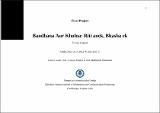Please use this identifier to cite or link to this item:
http://drsr.daiict.ac.in//handle/123456789/719| Title: | Bandhana Aur Kholna: Riti anek, Bhasha ek |
| Authors: | Pandya, Vishvajit & Mazumdar, Madhumita Desai, Riddhi |
| Keywords: | Ahmedabad Culture Vow orthodoxy Superstition Temple God Goddess Derasar |
| Issue Date: | 2017 |
| Publisher: | Dhirubhai Ambani Institute of Information and Communication Technology |
| Citation: | Riddhi Desai(2017).Bandhana Aur Kholna: Riti anek, Bhasha ek.Dhirubhai Ambani Institute of Information and Communication Technology.57 p.(Acc.No: T00634) |
| Abstract: | "Having an interest in understanding rituals and popular religious practices, I started my research with how the practices become a way to communicate something, how it becomes a representation or a symbol that allows people to communicate with one another. A simple ritual of tying and untying is deeply embedded in meaning and symbolism and is, in fact, a language of communication which people use across cultures and religions. In everyday life, in many rituals or everyday practices, we do the act of tying and untying. If you are interested in understanding the language of communication then how does the everyday ritual or everyday practice of tying and untying give us an insight into a different form of communication is what tried to be shown in the project. Acts of tying and untying are an integral part of our everyday lives. From tying shoe laces to tie hair, tying a kalawa, locking and unlocking a door, tying Rakhi on Raksha Bandhan, tying a knot in wedding, etc are important parts of our daily life. We tie and untie objects to keep them secure and safe, mobile and durable. Even the material we use to tie for instance a thread or a piece of cloth or a metal is strong and that?s why durable. But beyond such utilitarian purposes of tying and untying, we also see other acts of tying that symbolically, mark relations between human beings themselves and between human beings and the divine. The focus of your project is on these acts of tying and untying that reveal themselves as a language of devotion and affection that binds the God and his devotee. The broader impulse of my project derives from my interest in the issue of Culture and Communication. The main issue is the way people look at things, understand their acts. If we look at the rituals and the act of tying and untying in the rituals, at one level it is an act of belief, but on a deeper layer, it is a language of communication. I am trying to add some value to the acts of tying and untying by showing how it is more than the obvious means of tying and untying and by these acts how do the cultures communicate beyond the textual, visual and oral ways. The documentary as a medium to show this problem takes us from the ordinary realm of tying and untying to that of the world of belief, faith, devotion and rituals, where tying and untying becomes a way of communicating with God. These acts are common to all religions and communities, when we go deep into the topic, we realize how the language of tying and untying connects people of different faiths and communities. There may be a difference in rituals, objects but the faith in the acts of tying and untying are the same. Throughout the film, I am trying to show the observed patterns and commonalities of practices through people?s voice and from those patterns I am trying to show the broader language, where the thoughts and emotions of people are entwined with the act. There is a language of devotion and a common thread of stories of despair, loss, sadness and finally hope. Through this film, through the acts of hearing, knowing and sharing, we come to know ourselves and society a little better. In The Interpretation of Cultures (1973), Clifford Geertz outlined culture as ""a system of inherited conceptions expressed in symbolic forms by means of which men communicate, perpetuate, and develop their knowledge about and attitudes toward life."" According to Geertz, culture is the common interpretation of public signs and symbols. If we talk about symbols, we have representation for things in real world, so that we can communicate with one another, the symbolic meaning can change from culture to culture. Here, the act of tying and untying is same in a different culture in different events, but how it changes culture to culture and event to event is what I have tried to show." |
| URI: | http://drsr.daiict.ac.in//handle/123456789/719 |
| Appears in Collections: | M Des Project Reports |
Files in This Item:
| File | Description | Size | Format | |
|---|---|---|---|---|
| 201514003.pdf Restricted Access | 201514003 | 4.06 MB | Adobe PDF |  View/Open Request a copy |
Items in DSpace are protected by copyright, with all rights reserved, unless otherwise indicated.
